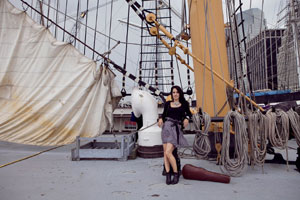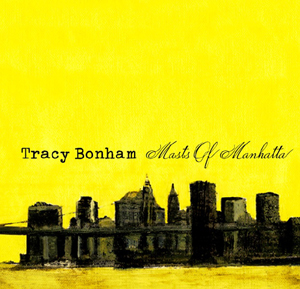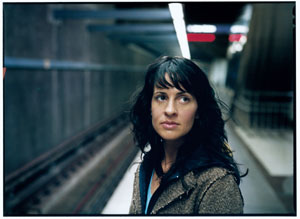Tracy Bonham: Swamp Things and String Theory with “Masts of Manhatta”
BOUERUM HILL, BROOKLYN: Notable American artists always feel like a find, and that’s just what’s found with Tracy Bonham’s new Masts of Manhatta.
Yes, admit it, that the woman who got your attention with her voice and violin on “Mother Mother” – way back in a land called 1996 – is always someone you’re at least momentarily interested in. So spend this year’s moment checking out Bonham’s arresting new collection, which comes out this Tuesday, July 13 on Engine Room Recordings.
Manhatta can be trippy, rootsy, hip hop-inspired, folkloric, Philip Glassy, romantic, rude, aggressively acidic and heart-breakingly apologetic – this is a surprisingly natural album from a beautifully blunt expressionist. Must-listens are songs like “When You Laugh the World Laughs With You”, “We Moved Our City to the Country”, “Josephine,” “Devil’s Got Your Boyfriend”…a bunch of ‘em.
An Oregon to BKLYN-transplant, Bonham hit the studios of NYC — primarily at Williamsburg’s Grand Street Recording — and her upstate cocoon around Woodstock, to make the collection. Subsequently mixed by Tchad Blake (Peter Gabriel, Phish, Elvis Costello, Soul Coughing, Lisa Germano, Sam Phillips), the album is a deeply reflective/introspective view from an Artist today in the USA.
This is your first record in five years. How have you evolved as an artist since then – what was the most important thing for you to express with Masts of Manhatta?
The five years in between records for me seems to be nothing new. I go into a cocoon, and say, “I can’t possibly make another record.” Then I start writing again, and all of a sudden I have a record.
But in that five-year span, I fell in love, got married, moved back to NYC from LA where I had a brief stint, and just really found myself in a way that I’d always hoped to.
I do music for the enjoyment, but there was always the stress of the career. I found people who were shysters, and said, “This isn’t for me.” I’d been playing music since I was five, and when the business got involved, it got ugly. Now I play music because I love it, and I don’t have any expectations.
I hope people hear the new album and love it, and I hope for new opportunities, but it’s more about sharing these songs with people the best I can, and just enjoying the people I’m playing with onstage. And I think that’s the most important thing.
Masts of Manhatta had two recording locations, Brooklyn and Woodstock. Tell us about the studios at those totally different environments – do you feel like different material resulted in each studio?
Yeah, I’m so happy with the way things went. I recorded the basic tracks at my friend’s studio in Williamsburg, Grand Street Recording, which is owned by Ken Rich and Andre Sherman. They’re dear friends of mine, and they have a really great spot with loads of gear — lots of vintage stuff, instruments and outboard, and they really know what they’re doing. Ken has become this amazing recording engineer.
We got a dream team together to record the basic tracks, including players like Smokey Hormel to play guitar. He’s incredible. He’s played with Tom Waits, and that’s the kind of thing I wanted — when I described the guitar sounds I wanted it was “swampy”. We got Smokey and his trio to come in, they banged out 11 songs in two days. It was the most effortless, painless recording of basic tracks I’d ever had. I was like, “Wow, what just happened?” We were just up and running, and making music from the moment we entered the studio.
We concur: That sounds dreamy! When did the project move upstate?
So the basics were done, and I took my little hard drive up with my little MacBook Pro, a basic Pro Tools rig, a decent mic – the Neumann TLM 49 – and a Focusrite compressor, went up to a 1920’s stone cottage in Woodstock, and did the best I could for overdubs. I didn’t have a boom stand, so when I wanted to record my violin I would jimmy-rig it. So I would put the mic stand on the bunk bed in the bedroom, and weigh it down so I would have the mic above me. It was very lo-fi.
Some vocals were also recorded in New Paltz, NY with Jason Sarubbi, at Split Rock Studio. I didn’t record my own vocals, just because you need to be thinking about one thing only.
What did you learn about capturing your violin during those DIY overdub sessions?
I still don’t know any more than I knew before! But the thing that made me so happy was that when I sent the tracks to Tchad Blake to mix, he said the violins sounded great. I realized I didn’t need all this high-quality gear. I’m too impatient. I prefer to ramshackle things. If I get a sound and it’s not hurting my ears, I just go with it. What I learned is if that I have the confidence, I can produce my own strings.
That and a good nights sleep, OF COURSE. So how have the particulars of capturing your two trademark instruments – your violin and your voice – changed?
For voice, I thought that maybe I could so some overdubs of vocals on my own, in my little cabin in Woodstock. But then I thought, “Don’t do that.” The voice is the most important thing. I want to be comfortable, and not worry about punching in. I wanted to go somewhere where I could trust the person, and just be myself. Most of the vocals were done in Williamsburg, some in New Paltz, and one extra song was done at the Blue Man Group studios on the LES.
Your violin playing certainly makes you special, but your voice has always been instantly recognizable as well. Would you say you’ve continued to evolve as a singer over the last few years?
I sound different form my first album (The Burdens of Being Upright) that came out in 1996. I was trying to dumb everything down (then). I came from a classical background, but I kind of kept a little personality hidden, or any of my vocal training, in line with what was happening at that time.
I wasn’t a big fan of Courtney Love or Hole, and my screaming in “Mother Mother” was a joke, but obviously no one would know where it was coming from. Then I opened up, and had the confidence to say, “I have a singing voice, and I’m not going to keep it under wraps.”
Now that it’s been 14 years, I can finally enjoy singing, I enjoy the lyrical aspect, and the sound of my voice, and I think that I’m done with trying to hide that from people. I feel liberated.
Welcome to Our World. That was an interesting choice in having Tchad Blake mix – why did you ask him to do it, and what did he bring to the table?
I could speak volumes about Tchad, he’s so amazing as a person and a mix engineer. He recorded and mixed my second record (Down Here) in 2000, with Mitch Froom and Tchad as the duo. He’s one of those people that is so incredibly loyal, and none of the bullshit of the business has affected him at all.
When I thought about mix engineers, I didn’t’ even think of Tchad because I had no money and I didn’t want to insult him. Then I decided to write to Tchad because he’s a friend, and he wrote back and said, “I would have been pissed off if you didn’t write to me.”
This is how lucky I am: He basically did it for love and friendship. He squeezed me in between projects — Suzanne Vega, Black Eyed Peas — he took some down time and he would work on my record. I’m forever in his debt and forever grateful, and if I ever make a cent on this record it will go to him for donating his time.
What was the album sound resulting from Tchad Blake’s mixes?
I know Tchad gets me. As far as how I wanted this record to sound, I trusted Tchad 100%. I said, “This should sound organic,” and he said, “Oh, I get it.” “And space, and warmth.” “Oh I get it.”
That was my criteria: space, rawness, organic sound, and the quirkiness that I have always been trying to get from my demos, and never get back in the studio when the big budgets are flying around. But I produced this myself, with no one breathing down my neck to say I can’t do the violin solo before the second verse. No one was telling me not to!
So I finally managed to capture what I was thinking and creating at the time. And no songs were laying around from years past, these all went in the natural flow and came out exactly the way I was hearing in my head. That’s a hard place to get to, especially when there’s a lot of folks around. You need to be able to express it, and not compromise.
How is this going to synch up with your live element? Are you touring on Masts of Manhatta?
The idea is to tour in the summer and the fall. My ambitions are a lot smaller – mainly it’s hoping we can get some music licensing going. But touring, to be honest, is…I’m not 25 anymore. I’m married, got two dogs and I’m adopting a kid. I’ll get out there as soon as I can, but I’m not really in the mind to get back out into the van.
— David Weiss
Please note: When you buy products through links on this page, we may earn an affiliate commission.







